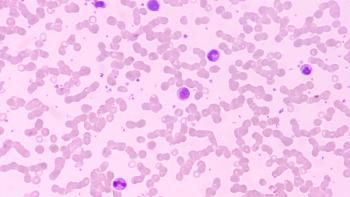
Glecirasib Elicits Responses With Manageable Safety in Pretreated KRAS G12C Mutated NSCLC
Glecirasib resulted in durable responses with a manageable safety profile for pretreated advanced non-small cell lung cancer with KRAS G12C mutations.
Patients with previously treated advanced non–small cell lung cancer (NSCLC) harboring KRAS G12C mutations who were treated with glecirasib (JAB-21822) monotherapy experienced durable responses and displayed a manageable safety profile, according to data from the pivotal phase 2b trial (NCT05009329).
Findings presented during the 2024 April ASCO Plenary Series showed that patients treated with the KRAS G12C inhibitor (n = 117) experienced a confirmed overall response rate (ORR) of 47.9% (95% CI, 38.5%-57.3%) per independent review committee (IRC) assessment, which included a complete response rate of 3.4% and a partial response rate of 44.4%. Additionally, 38.5% of patients had stable disease, 10.3% had progressive disease, and 3.4% were not evaluable (NE) for response. The disease control rate (DCR) was 86.3% (95% CI, 78.7%-92.0%).
“This phase 2 study of glecirasib monotherapy met the primary end point [of ORR]. This study demonstrated promising efficacy [for glecirasib] in [patients with] previously treated, KRAS G12C–mutated NSCLC,” lead study author Yuankai Shi, MD, PhD, of the National Cancer Center/Cancer Hospital, Chinese Academy of Medical Sciences and Peking Union Medical College, said in a presentation of the data.
The single-arm, phase 2b trial evaluated the covalent, highly selective KRAS G12C inhibitor in patients with advanced or metastatic NSCLC harboring a KRAS G12C mutation. Patients needed to be refractory or intolerable to an immuno-oncology and platinum-based chemotherapy regimen. Those with active brain or spinal metastases were not allowed to enroll.
All patients received oral glecirasib at 800 mg once per day. ORR per IRC assessment served as the trial’s primary end point. Secondary end points included investigator-assessed ORR; investigator- and IRC-assessed duration of response (DOR), DCR, time to response (TTR), and progression-free survival (PFS); overall survival (OS); safety and tolerability; and pharmacokinetics.
In the overall population (n = 119), patients had a median age of 62 years (range, 40-80). The majority of patients were under 65 years of age (56.3%), were male (79.0%), had an ECOG performance status of 1 (80.7%), were past smokers (59.7%), had adenocarcinoma (95.0%), did not have brain metastases (83.2%), and had TNM (tumor, nodes, metastases) stage IV disease (95.0%).
Additionally, 51.3% of patients received 1 prior line of therapy, 42.0% underwent 2 prior lines of therapy, and 6.7% were given 3 prior lines of therapy. Notably, 94.1% of patients were previously treated with platinum-based chemotherapy and a PD-1/PD-L1 inhibitor.
Shi noted that ORR was consistent across specified subgroups of patients. “[However], the ORR appeared to be higher in patients with an ECOG performance status of 0 [65.2%], [those who received only] 1 line of prior treatment [52.5%], and [those] without central nervous system metastases [50.5%],” he said.
Additional data showed that 30.8% of patients evaluable for efficacy achieved a tumor reduction of more than 50%. At a median follow-up of 10.4 months, 34.2% of patients remained on treatment. The median TTR was 1.41 months (range, 1.2-9.8). The median DOR was not reached (95% CI, 7.2-NE). The 6- and 12-month DOR rates were 73.6% and 56.6%, respectively.
Glecirasib led to a median PFS of 8.2 months (95% CI, 5.5-13.1), and the 6- and 12-month PFS rates were 56.6% and 40.0%, respectively. The median OS was 13.6 months (95% CI, 10.9-NE), and the respective 6- and 12-month OS rates were 83.0% and 54.6%.
Regarding safety, any-grade treatment-related adverse effects (TRAEs) occurred in 97.5% of patients, including 39.5% of patients who experienced grade 3 or higher TRAEs. The rate of serious TRAEs was 19.3%. No grade 5 TRAEs were reported. TRAEs led to dose interruption, reduction, and treatment discontinuation in 37.8%, 18.5%, and 5.0% of patients, respectively.
The most common TRAEs included anemia (any-grade, 56.3%; grade 3/4, 4.2%), increased blood bilirubin (48.7%; 6.7%), increased alanine aminotransferase (35.3%; 10.9%), increased aspartate aminotransferase (35.3%; 10.9%), hypertriglyceridemia (28.6%; 7.6%), increased gamma-glutamyl transferase (15.1%; 5.9%), increased conjugated bilirubin (13.4%; 1.7%), decreased weight (12.6%; 0%), anorexia (12.6%; 1.7%), increased alkaline phosphatase (11.8%; 0%), decreased white blood cell count (11.8%; 1.7%), decreased neutrophil count (10.1%; 4.2%), hypoalbuminemia (10.1%; 0%), and proteinuria (10.1%; 0%).
Shi added that minimal gastrointestinal (GI) TRAEs were reported, which included grade 1/2 nausea (5.9%), vomiting (7.6%), and diarrhea (3.4%). One patient (0.8%) had grade 3 nausea.
In a discussion following the presentation, Julia Rotow, MD, a physician and clinical director of the Lowe Center for Thoracic Oncology at Dana-Farber Cancer Institute, and an assistant professor of medicine at Harvard Medical School, both in Boston, Massachusetts, explained that the low rates of GI toxicities observed in the study were notable. However, she explained that the rates of grade 3 or higher hepatic AEs will require monitoring in subsequent studies.
“Glecirasib may offer efficacy and tolerability advantages over current FDA-approved KRAS G12C inhibitors, but further randomized and prospective studies are needed,” Shi concluded.
Disclosures: Dr Shi did not disclose any relationships. Dr Rotow reported receiving consulting fees or honoraria from Amgen, AstraZeneca, BioAtla, Bristol Myers Squibb, Daiichi Sankyo, Genentech, G1 Therapeutics, Guardant Health, Janssen, Jazz Pharmaceuticals, Pfizer, Sanofi-Genzyme, Summit Therapeutics, and Takeda; and being contracted for institutional research with AstraZeneca, BioAtla, Blueprint Medicines, Enliven Therapeutics, Blueprint, Black Diamon, LOXO Oncology, ORIC Pharmaceuticals, AbbVie, and RedCloud Bio.
Reference
Shi Y, Fang J, Xing L, et al. A pivotal phase 2 single-arm study of glecirasib (JAB-21822) in patients with NSCLC harboring KRAS G12C mutation. J Clin Oncol. 2024;42(suppl 36):468214. doi:10.1200/JCO.2024.42.36_suppl.468214
Newsletter
Knowledge is power. Don’t miss the most recent breakthroughs in cancer care.




















































































